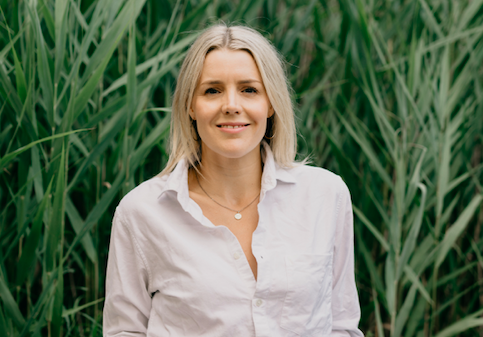On this week’s episode of Let’s Talk About…, Elise sits down with co-host Sarah Joseph to talk about how to change our thoughts.
Sarah is a certified emotional intelligence coach whose mission is to help you get comfortable with your emotions and master them to live a more purposeful life. She understands how our lack of emotional management can impact the longevity of our relationships and can inspire our emotional healing by plugging into our most powerful tool, the Mind. Her philosophy is that our emotions show up in every aspect of our lives and it’s your right to learn how to manage them effectively to your advantage.
On this week’s episode, Elise and Sarah talk about how to process and change our thinking, detaching ourselves from our thoughts and feelings and deliberate thinking.
“We are not our thoughts and we are not our feelings. They happen to us, they happen for us, but they don’t happen because of us.” Sarah tells Elise on Let’s Talk About.
Check out our episode’s full transcript below.
[00:00:00] Elise: Hi everyone, and welcome to this week’s episode of Let’s Talk About. We’re continuing our series on emotional intelligence with certified emotional intelligence coach Sarah Joseph, and today we’re talking all about how you can change our thoughts.
Hi Sarah.
[00:00:15] Sarah: Hello. I’m so excited for this topic. I can’t wait to get into it.
[00:00:19] Elise: Yeah, and so last week we talked all about that self-coaching model. So today’s kind of the first part of that, like how do we actually go about changing our thoughts? So let’s start with that question, I guess. Like how, how do we change our thoughts?
[00:00:34] Sarah: Exactly. So we went into last week into that thought model, like you said, the self-coaching model. And what it taught us is that our thoughts create our feelings and our feelings create our action and or inaction. And those actions create the results that we wanna see in our lives. Right. And what we wanna do is take a step back then and go in to learn how we can process and change our thinking so that we can create more of the feelings we wanna feel, so that we can create the action, take the action we wanna take, and create the results in our life that we want to take.
So in order to start changing your thinking, what you need to do is start to process your awareness, so bringing in your emotional awareness in terms of understanding what on earth is going on in our mind, right? We have millions of thoughts swirling through our mind every single day, and a lot of those thoughts create feelings which generate our thinking, which generate our results.
So what we wanna do in the self-awareness part is to go in to ask why. That is one of the biggest questions that we can ask ourselves, so that we can begin to understand our emotional healing and begin that journey in general. So when we’re having those thoughts of maybe, you know, I don’t feel worthy, or I don’t feel un, I feel unlovable, or I hate X, Y, and Z, right?
Asking yourself from a place of curiosity, about why? I think the way that I think really question that and get to know that, and it doesn’t mean that we need to go into this downward spiral of uncovering and digging up all this, you know, past trauma. And it does come from there. But what we can do is go into uncover just the part parts of it that help us become more aware of our thinking and.
Where that awareness leads us when it comes to our reaction. So how are we reacting, when we’re feeling triggered, and if we’re feeling triggered, what’s causing me to feel triggered, and then what’s causing a reaction out of that or what’s causing the results that I’m getting after that? So a lot of what we’re gonna be doing now for that self-awareness piece is to catch yourself before you.
That is kind of the punch line here. That’s how we begin to become more self-aware is catching yourself in the act of reacting. And it’s funny because this is gonna take some time and practice. , and it’s simply because we are not so in too in tune enough with our thinking and our feelings and our actions that it makes us unaware of why we’re thinking the way we’re thinking.
We’re just kind of working automatically, right? Our brain just has all these. All this programming and beliefs and experiences from our past that are still working in our adult life today, but maybe they don’t serve us anymore. Right? So what we wanna do is get to know what on earth we’re thinking and watch your own mind from a third party perspective.
So what you’re doing is kind of doing is ease-dropping in on your mind and listening in on your mind, and listening in to what’s really going on in there so that we can make those changes.
[00:03:42] Elise: I like that, like ease dropping on yourself.
[00:03:44] Sarah: Exactly spying on yourself and going, huh? What do I think? The way that I think,
[00:03:49] Elise: So that’s basically like the time where you would pause, you’re doing that pause to just kind of not have the result that maybe you’ve always had.
Exactly. If we’re using the example of an argument or something like that. Okay. Can, can you take us through like what that would look like in a real life situation .
[00:04:08] Sarah: Yeah, for sure. So the practice of catching yourself when you’re reacting or before you’re reacting happened to me literally yesterday, and this is something I’m still working on.
So, . I was at the nail salon yesterday and I was, uh, getting a mani-pedi done and I was getting my pedicure done, and then there was this other couple there, and the woman, there was a man and a woman, and the woman was trying to buy a lotion that the nail tech had used on her hands, and her husband had said no, and that he was not paying for that and that she didn’t have enough money to pay for that.
And it kind of went on from there. So the argument kind of started, the trigger started for them right there. And then she kind of went, well, I don’t want the lotion anyways because I don’t wanna hear about it later. And she started talking to the nail tech about her money, his, how he controls her money, and how he controls her spending.
And it’s her money anyways. And he doesn’t, she doesn’t understand why she can’t buy this lotion. And it just kind of made a big ruckus in the salon and everybody heard it like it was a small salon. And myself included, like I turned around to look right because
[00:05:15] Elise: it was a salon soap opera.
[00:05:17] Sarah: Literally , that’s exactly what’s happening, right?
And. . What I noticed was, although that was a separate situation for me and that was happening, what was happening for me was I was becoming a little anxious, but I wasn’t aware of my thinking. I was aware of what I was feeling. So what I was feeling was my heart was palpitating. I had a shortness of breath a little bit, and I was getting a little sweaty in my palms, and I was tingling a little bit in my arms, in my palms, and I was like, whoa, what’s happening to me right now?
Slowed the process down. And so what I did was I took a few minutes to acknowledge what I was feeling and I was going, whoa, I’m feeling some sensations right now. Am I feeling anxious? And I went, yeah, I guess I’m feeling a little anxious. And I asked myself why. Right? And the thoughts that came up from that were, Well, what if the argument gets worse and they start hitting each other?
Right? What if, um, I have to get involved because of the hitting, right? What if someone else gets involved? What if this escalates and nobody advocates for her or for him because it was clear that he was looking a little embarrassed at that point, right? . And for me, what went further into that was I am the type of person that doesn’t like to see injustice happening, especially in public, right?
And I’m the type of person that likes to advocate for people, especially when they’re not sure how to advocate for themselves. But the way that I’ve done that in the past was from this place of an anxiety and fear and scarcity, right? And I was really scared that this would escalate and that comes from my childhood and seeing, you know, people argue and not liking it, right? Seeing my parents argue, and always coming to this really horrible, raw solution at the end that didn’t serve anybody. That didn’t help anybody, right? It didn’t create a solution. It wasn’t as a resolution based thinking. It was just fear-based thinking.
And I noticed that was coming up for me. And then what I decided to practice was detaching myself from not only my thoughts and my feelings because we are not our thoughts and we are not our feelings. They happen to us. Right? They happen for us, but they don’t happen because of us. If that makes sense.
[00:07:29] Elise: So meaning like our past or our thoughts. Okay. Like meaning our past kind of influences.
Okay. .
[00:07:35] Sarah: Got it. So when you can practice that detachment, you can literally pull yourself out of it and kind of look at your thoughts and your feelings like in the palm of your hand. And that gives you more control. So you’re now going, okay, that, that looks really cool. That’s interesting. That’s fascinating.
Why do I think that way? I’m really curious about that. Right. Whereas most of us kind of go into our thinking and we go, why do I think like that? I wanna stop thinking like that. That’s horrible to think, I don’t wanna think that I’m not good enough. I don’t wanna do this, I don’t wanna do that. And we.
invalidation, right? Mm-hmm. . But when we go in with curiosity and fascination, we’re going in with, wow, that’s really interesting to think. Why do I think that way? Right? Mm-hmm. . So what I later did was starting to practice deliberate thinking, and deliberate thinking is more supervised thinking, and it allows you.
Think more consciously. So what I did was I redirected my mind and redirected my focus and redirected my thinking to what I really wanted to my intentions. So why did I show up to the nail salon today? Was it to get into a fight? Was it to feel anxious? Was it to get into an argument? No, probably none of those things.
Yeah, no . I came to pamper myself, right? And even though I’m feeling triggered, and I do wanna advocate, don’t get me wrong, I did totally wanna stand up for those two. But will it, can I stand up for them at the expense of my own emotions, right? Mm-hmm. , because at that point, if I do anything, . I’m not only, you know, probably gonna make that worse because I’m feeling triggered from my own story and my own storyline in my own childhood that has absolutely nothing to do with that couple, right?
Mm-hmm. . Mm-hmm. , and I’m attaching myself to their story when I can just. Detach myself, right? And notice that this is happening for me and only me, and I need to be here for me and not abandoning myself in this process. That I can do this right, and I’m willing to feel this painful emotion right now so that I can gain control of it.
So the other part of that self-awareness piece is being willing to feel negative. So the reason why a lot of us avoid and resist our emotions is because we are not comfortable or familiar with feeling a negative emotion. , we’re always running and avoiding them because those sensations feel way too heavy.
Those, you know, that breathing that happens for me, I don’t like it. And when we’re afraid to feel our feelings, what happens is we become more afraid because we don’t ever familiarize ourself with it. We don’t get to know it. Right. And it’s kind of like dating your emotions. And that’s kind of how I like to think about date sadness, right?
Date anger. date, overwhelm, date anxiety, date fear, and get to know who they are, why they’re showing up, and what they’re here to, what function they’re here to serve. And as you date all of these emotions, what you’re gonna notice is you’re gonna find out more information about them and you can decide how you wanna think about them.
So you gain more control that way. So I decided a long time ago, I decided to start dating my anger, right? And I was like, okay, I’m gonna start to get to know why this anger is showing up, how it’s showing up, how it feels in my body, what thinking comes with it. I’m getting to know all the pieces about it.
And now that I know the pieces about it, I’m not afraid to feel anger anymore, right? Mm-hmm. , I’ll allow myself to go through five minutes of feeling. You know, change in my energy, that change in my breathing, that change in my heart, that little fluttering that’s happening, and I’ll let it pass and regulate through breathing.
Right? And once it’s gone, I can focus on the thoughts. Right? And now that I have access to my thought thinking and my thoughts, I can now begin to change them. Look through that thinking.
[00:11:17] Elise: So would someone come to you and just say like, in your role as a coach, would someone just say, I’m anxious? Mm-hmm. and then, and I’ll give an example.
Flying yesterday I was like super, not so much anxious leading up to it, but anxious on the flight. When it got turbulent, I got like really anxious in the last few years. Right. That was always flying before. So is that something that like someone would just be like, I’m feeling anxious in these specific scenarios, and then you would relate that back to something else?
Or could it just be that like, I mean maybe anxiety is a standalone, like could it just be. anxiety is situational or like how, like how would you work through
[00:11:59] Sarah: that? I. . It’s definitely situational, right? Yeah. So the first part of that is allowing yourself to feel anxious, right? And validating the fact that your survival was threatened in that moment, right?
That little bit of turbulence caused you to feel anxious because it was saying, Hey, what if this plane goes down right now? Right? , oh, I like literally what? Right? and validating that that’s what you’re feeling. And then once you’ve been able to regulate the thoughts and understand, anxiety is here to protect me from something.
It’s signaling to me that there’s danger coming or danger that could be coming. How do I go to, in how I go? How do I go in now to deliberately help and help my thinking and manage my thoughts so that I could feel better? Right? So maybe. Some thinking that could happen there. Instead, when you’re redirecting your thinking from, oh my God, this plane is gonna go down and I’m gonna die to, well, we, when you’re in a plane, you’re gonna experience a little turbulence because that’s a natural flow of flying in the air, right?
It doesn’t mean the plane is gonna go down, it’s just going through its natural flow to get through an air pocket. Right? And if that’s the case, then that’s exactly what’s gonna happen and I’m gonna actually be okay because. Hey, they don’t just hire any willy-nilly to fly a plane , right? Yeah. What do they do?
True. Hire someone that has years of experience that’s gone through testing and, you know, programs and has done this for so long that you can trust your captain, right? Mm-hmm. , so, so it’s,
[00:13:27] Elise: it’s also probably in that situation, sorry, go f sorry.
[00:13:30] Sarah: That’s just where you’re bringing in rational.
[00:13:32] Elise: Yeah. Okay.
Interesting. I feel like we probably do a whole episode on anxiety and a whole episode on anger, like we could, that would be kind of interesting actually to like analyze each emotion maybe. Um, okay. So the idea isn’t, so if we can control these reactions with the deliberate thinking, , like the idea isn’t to always just think positively.
The idea is to like, like you said, date those feelings.
[00:13:55] Sarah: Mm-hmm. . So what’s interesting is that if you don’t ever tell your mind how to think, so give it deliberate thinking. It’s always going to think the way it thought in the past because. , the way it thought in the past is a habit, right? Mm-hmm. . And if we’re used to constantly having frustrating or anxious thoughts, it’s always gonna generate frustrating and anxious thoughts, right?
Mm-hmm. or stressful thoughts, and that’s not what we want. So we need to understand that we can make a choice in what we choose to think so that we can control the way that we feel, right? Or have more ownership over the way that we feel, if we can put it into better words. So, and you’re right, we don’t wanna enter.
Place of just having positive thoughts, right? So going from a negative thought to an immediately positive thought will not work, and it’s only a temporary bandaid. It’s. Having a garden full of weeds and then planting flowers in them, it’s gonna happen. The weeds are gonna grow right through the flowers and destroy the flowers.
So, although you’re trying to do something positive, what we’re doing is masking the negativity, and that can go so many ways because. . If a negative thought or a negative feeling is living inside of your body and our emotions are all living, then that means they’re harboring space, they’re living and breathing, and they’re still alive in your daily life.
No matter how much you try to mask them, no matter how much you try to avoid and resist them, no matter how much of how much positivity you try to throw on top of it. It’s always gonna be there if we never actually go in to neutralize it and think about it and feel it and allow ourselves to feel it and be willing to feel the painful emotion or the painful feelings that come with it.
So what we don’t wanna do is go and throw in a positive thing, positive thought. We don’t wanna go from, let’s say, for example, I am, I am. . I hate my body. Sorry to, I love my body and it’s beautiful and wonderful. Right? So there are two things that you need in order to change a thought. You need to believe it and you need to feel good about it.
And if you don’t have those two things in a new thought that you’re trying to think, well then it’s just a temporary bandaid and it’s not gonna work. Mm-hmm. , what we need to do is go into, create a neutral thought, maybe not a
[00:16:07] Elise: can I ask the question there for a second? So, you know, when we say affirmations, like if we continue to say, I love my body, does that, do we then start to believe it and so then it could work or no.
[00:16:21] Sarah: what you wanna do is start with a neutral thought. So there’s kinda a hierarchy of building your way up to getting to, I love my body. Right? Ok. So if you’re going from, I hate my body and then going to, I love my body, you don’t believe it and you don’t feel good about it. You when, if you say that from a person that hates their body, you’ll probably feel a little icky.
It’ll feel a little uncomfortable, and you’ll. Uh, I don’t believe that, but I guess I’ll keep saying it. Right. But if you don’t believe it and you don’t feel good about it, cause he keep saying, continuing to keep saying, it won’t make you believe it more. Right. Right. Okay. So what we wanna do is train the mind in kind of a step by step process to working up to saying, I love my body,
my body is amazing, right to from, I hate my body. So what we wanna do is go into the middle ground, and that’s a neutral thought. Mm-hmm. , to create a neutral thought, you wanna take out the negative word or take out the negative connotation. So instead of saying, I hate my body, what you can say is, I have a body.
and that neutralizes you and it creates some believability. So you believe, yeah, I have a body, right? Mm-hmm. , or it could be, I have a functional body, right? You can walk, you can talk, you can look, you can see, you can eat, you can breathe, right? And it’s maintaining your survival. Even if you hit your body, it’s still functional.
It’s still doing the things that you wanted to do, and that’s a really, really good place to start, right? Starting in a place where it’s neutral and you can believe it and you kind of feel good about it, start there. And then what you wanna do is start implementing bit by bit. and no. Having your body notice in your mind, notice that you have a body, that it is functional and reminding it that it is those things so that we can eventually take that and turn it into a positive thought when you are ready, when you’re able to believe it, and when you’re able to feel it.
So we can definitely get into toxic positivity here if we jump from a negative to a positive. So what we wanna do ladder and go from negative to a neutral thought and then to a
[00:18:21] Elise: positive. . Okay. Interesting. I’ve never, um, heard of the concept of a neutral thought before. I don’t think Yeah. . Cause we so often are just like, you know, positive thought or, okay.
So that’s interesting. So that embracing, so when it comes to how we embrace those negative thoughts instead of avoiding or resisting them, is that how we embrace them? Like giving that neutral thought is the middle ground and then, or, or is there a different process? I guess there may be a little bit of a different process than how we embrace the negativ.
Right.
[00:18:49] Sarah: So what we don’t wanna do is again, mask that negativity with funding. Yeah. So now we know we wanna go to a neutral thought, but that doesn’t mean the negative thinking is gonna stop. Right? You’re still gonna have it. So how do we then go ahead to embrace a neutral thought now when we’re still having a negative thought?
And what happens there is we need to be willing again, to feel what we feel, be willing to feel the negative emotion that’s coming up so that we can have ownership and control over it so we know what we’re dealing with. And then what you wanna do is to greet and invite that negative thought in. So what we don’t do is when we have a negative thought, we go, I don’t wanna think like that.
Don’t think like that. Don’t think like that. And what we do is we avoid and reject it, right? Mm-hmm. . But what we wanna do is greet. , right? Welcome it in and go, Hey, I noticed you. I see you because all our, all our thoughts really want is to be noticed. They just want a bit of your attention. And how I like to think of my thoughts and my feelings is like a little toddler, okay?
And when they’re knocking on the door, you know how to toddler want something to eat. They wanna go outside and play. They nag you all day, right? They remind you constantly that they’re here and they wanna do this thing. You said you’re taking me out for ice cream. When are we going out for ice cream? Are we going out for ice cream?
so they’ll keep nagging you. So what you wanna do with that nagging thought or that nagging child is to give it the attention that it’s asking, right? Give it a little bit of space and to greet it and say, Hey, I see you. I hear you. I feel you. I’m here for you. I don’t have to like it. I don’t have to want it, but I can allow it in for a few minutes so that I can process.
So I can allow it. So what you’re doing now is going, I hate my body, I hate my body, I hate my body. And then you’re noticing it. You’re catching when you’re reacting, right? And then you’re going, I have a body. I have a body. I have a body. And s reassuring and reinforcing that thought, even when the negativity comes up.
And then eventually it’s gonna be, I have a body. . It’s not gonna be, I, I hate my body. Why? And that’s because the neuro pathways and cells in your brain are changing because you’re constantly going in to give it repetition. The body, the brain likes repetition. It likes to do things more than once. And if it does things more than once, it will catch on and then throw it into your subconscious.
So what we wanna do is replace the thought that’s sitting in your subconscious, which is that I hate my body and we eventually wanna do it. Repeat that thought enough. I have a body. I have a body. I have a body enough that it replaces that negative thought and it sits in our subconscious now, right? So we’ve gone into reprogram our brain essentially.
[00:21:22] Elise: And we can’t just jump to the, I love My body because we don’t believe it yet.
[00:21:26] Sarah: Essentially we don’t believe it and it doesn’t make us feel
[00:21:29] Elise: good. Okay. Interesting. Yeah. Okay. And then, okay, so we know that, how long do you, is there a timeline on like how long that process takes to, you know, to get to that point of from, I hate my.
and then I, I have a body which I’d imagine with, I have a body. There’s some gratitude there too, right? Like that kind of creates gratitude. Mm-hmm. . And then two, I love my body. Like is there, is there any science around like this takes. Five months , like is there anything like that or is just individual dependent on how often it’s practiced, I’m assuming?
Exactly.
[00:22:06] Sarah: Yeah. So it’s dependent on, at least for me, I’ve noticed that it’s dependent on how often you practice it and how often you’re willing to feel the negative feelings and have willing to embrace those negative thoughts. And if you’re unwilling, it’s okay to admit that you’re not willing. , right?
It’s okay to admit that you’re still scared and that you need some time to get comfortable and feel safe in your body to be able to feel a negative feeling, right? A lot the, a lot of the time, the reason we don’t feel a negative feeling is cuz we don’t feel safe feeling it. We don’t know how to control it and manage it.
But say you’re working with a coach or a therapist or a friend that you know can help you sit, create that safety for you, then you’re more likely to embrace those feelings than you would. If you didn’t, if you didn’t work with someone or if you didn’t have that conscious thinking. So it would take some time.
And a large part of that time comes down to whether or not your goal setting. So a large part of why this takes so much time is because we don’t know why we’re doing it. , right? We know we have this thought. We know that it’s affecting, you know, my life in this way, but why do I wanna change it? What does changing offer me right now?
What new experience in life does it bring to me? And how does it change my life for the better of myself? And when you can know your why as to why you’re doing something, you’ll be able to use that in your motivation to continue saying, I have a body. I have a body. I have a body. Because you want that end result.
You want that? , right? But you have to take the little micro shifts in between in order to get to where you wanna be. So
[00:23:35] Elise: basic. Okay. I love that. So basically how we start thinking about, what we want to think about is that middle kind of neutral thought and then we get to, got it. Okay. So what is the biggest problem with our thoughts?
[00:23:50] Sarah: The, there are two big problems. Okay? Okay. The first one is that we’re not aware that we can choose our thoughts, right? Yeah. Okay. And. . What’s crazy is that before even starting my own healing journey and practicing choosing my thinking and deliberate supervised thinking, I was always reacting to unconscious thoughts, right?
And I never thought that was something I could have control over. I was like, oh, my mind just does it right. But what we need to go do is give our mind new information. About, you know, ourselves, about the world around us, about how we wanna think and feel so that it can be controlled, so that we can start to manage it instead of reacting to it, but instead of responding to it.
So that’s the first problem. Your thinking and your feelings are all choices. You can make a deliberate effort to feel and think and choose what you wanna feel and think the other part. people go into when they’re going in to change their thinking, they’re going, well, I wanna feel positive thoughts all the time.
The problem with that is we actually don’t wanna feel happy a hundred percent of the time. In fact, there are times we want to choose to feel sad and have sad thinking, right? To generate that sad feeling. And here’s an example. , I would not wanna feel happy if I heard that one of my close friends passed away.
I would wanna feel sad about that, right? Mm-hmm. , I wanna deliberately and intentionally feel sad about that. So what’s gonna happen? My mind is gonna create thoughts that, you know, remind me of that person that reminisce in that person that can’t believe what just happened, right? And what that’s gonna do is gonna crad a bit of sadness.
For me, right? And that’s gonna help me sympathize a little better. That’s gonna help me feel the situation a little better. That’s gonna remind me that I truly loved this person in my life and that I can’t believe that they’re gone. And that’s okay to feel. You want to feel that sometimes. So a large part of the time, we wanna be sure that we wanna understand whether or.
We wanna feel happy, whether or not we wanna feel sad and embrace feeling all of it. Date all of your emotions. Again, going back to that right? I wanna feel sadness sometimes. I wanna feel angry. Sometimes I wanna feel happy. Sometimes I wanna feel excited sometimes, but sometimes you don’t wanna feel anything.
Sometimes you just wanna feel. Have you heard days where you’re
[00:26:10] Elise: just not feeling, my God, how do we get to neutral? Yeah. I wanna be neutral today. Yeah. So
[00:26:13] Sarah: sometimes when we’re overstimulated, when we felt too much in the day, whether that’s sadness or happiness or excitement or anxiety, we kind of have days where we’re not really feeling anything.
We’re just chilling. We’re vibing, we’re neutral. Right? And that’s exactly sometimes what we wanna feel. and that’s an okay feeling to embrace as well. So you don’t always wanna feel something and you don’t
[00:26:34] Elise: always wanna Yeah, that’d be exhausting probably. Yeah.
[00:26:36] Sarah: It’s so exhausting, so drained in your energy
[00:26:39] Elise: Yeah. Yeah. Now I, okay, that’s interesting. I never thought, yeah, I guess we’re, I am sure we’re always like, to some extent. Sure. We always some, I’m also sure on the spectrum, like some people are more always in their emotions than other people. Is that fair to say? Like, are some people. more highly emotional than others or.
not highly emotional, but like highly more aware of their emotions or something like that. I, I’m guessing that’s they’re little, little more sensitive to their ok. Sensitive to their emotions, the word I was looking for. Ok. Yeah.
[00:27:10] Sarah: And that’s actually a really good thing, right? That’s not a bad thing at all.
Um, in fact, a lot of us wanna become more sensitive to our emotions so that we feel them more so that we can have more control. Mm-hmm. . So I would say the people that are a little more hypersensitive have more control than they think. Right. Um, I know I’m somebody that’s pretty hypersensitive and I feel everything and.
Feel every emotion and all my thinking. Creates my feeling. Like I definitely feel that, and that’s actually my greatest superpower, right? So it helps me to empathize more with people. It helps me to understand myself better, and it helps me to, you know, be more in tune with things like my intuition, right?
And that’s not something that people really talk about as often when it comes to our emotions and our feelings. Well, When you have access to your emotions and your feelings, and you have proper access to conscious thinking, you actually have so much more control over your intuition and decision-making than you had ever thought before.
So definitely is an interesting concept when it comes to hypersensitivity.
[00:28:10] Elise: I feel like we can, that would be a whole conversation too, so. Well, yeah, we talked a little a lot today. Thank you so much. Um, and I know we’re gonna dive into even more next week, so can you remind everyone where they can find you on social?
[00:28:24] Sarah: Yes, they can find me on Instagram @sarahjoseph_coach TikTok @sarah.eicoach, and then Twitter. You can also find me on shemadedigital.com. It’s, I actually have an article coming out on March 2nd on my five-step process, so you can check that out.
[00:28:39] Elise: Oh, amazing.
[00:28:40] Sarah: I’m super excited for that to launch as well.
[00:28:43] Elise: Oh, awesome. I look forward to reading it. Well, thank you Sarah so much for today and we will chat with you all next Tuesday.
[00:28:49] Sarah: Thank you so much for having me. I can’t wait.










